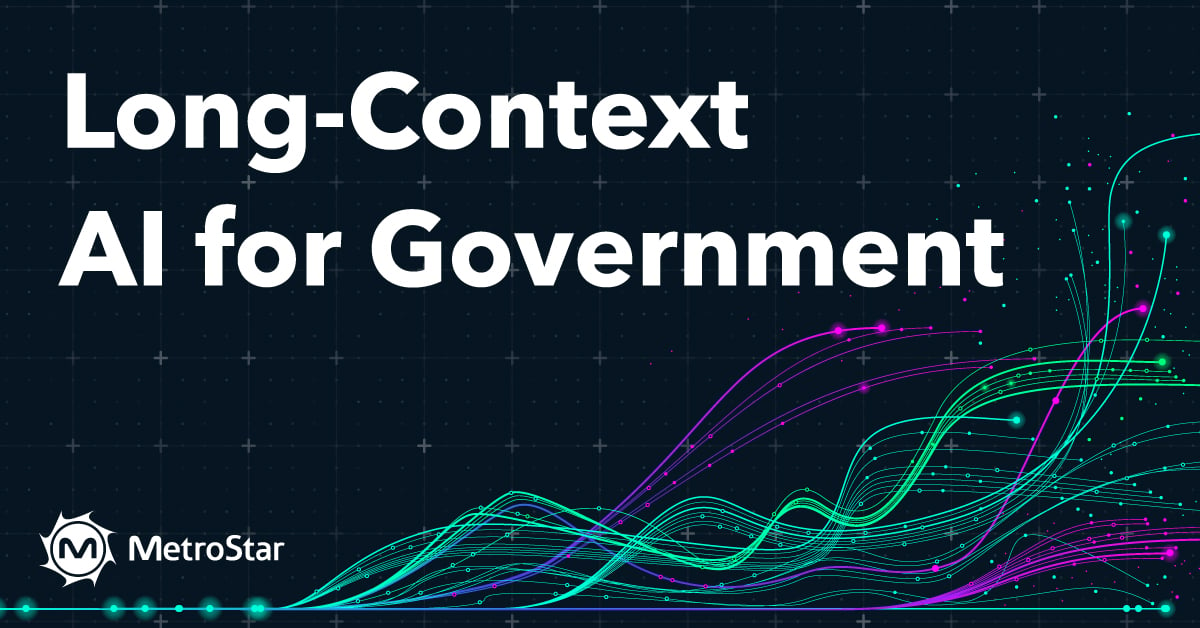Why LLM Context Limits Undermine Mission Readiness and How to Fix Them
3 MIN READ

The Problem: Why “Context Window” Limits LLM Usefulness
Large Language Models (LLMs) have transformed natural language understanding. But their limited “context window”—the amount of text they can process at once—creates real bottlenecks when working with lengthy, dense documents.
Defense analysts, for example, often work with dozens of multi-page OPORDs, intelligence summaries, and acquisition contracts. Traditional LLMs, even with chunking strategies, lose coherence, cross-references, and context, which undermines the very analysis they are intended to support.
This isn’t just a performance issue. For mission-critical use cases, like compliance auditing or multi-source fusion, it’s a reliability risk.
What’s Needed from LLMs in the Field
Analysts and operational users need AI systems that can:
-
Provide quick responses for real-time intelligence and decision support
-
Ingest and analyze entire documents in a single pass
-
Retain nuance and semantic relationships across thousands of tokens
-
Operate in secure, scalable environments from classified on-premises systems to cloud-based deployments
These requirements are especially pronounced in government contexts, where infrastructure constraints, security compliance, and high accuracy thresholds converge.
An Open, Scalable Approach: AI Services for Long Context
A viable solution must extend beyond the model itself. It requires infrastructure to:
-
Manage a wide range of models (LLMs, vision, embeddings)
-
Serve them at scale (CPUs, GPUs, containers)
-
Enable retrieval-augmented generation (RAG) for multi-source knowledge
-
Operate flexibly across deployment targets: GovCloud, air-gapped servers, tactical edge, etc.
An example implementation combines Kubernetes-native orchestration with ML lifecycle tools like MLflow and Python APIs, allowing fast model iteration and consistent deployment.
To address the limitations of standard model inference engines, long-context workloads benefit from optimized serving frameworks like vLLM.
Why vLLM?
vLLM introduces "paged attention," a GPU memory management technique inspired by virtual memory in operating systems. This allows models to handle significantly longer input sequences without fragmenting memory or degrading performance.
Benefits:
-
Context Extension: Better model intelligence around long input sequences
-
Higher Throughput: 4–5x more requests per second
-
Lower Latency: Up to 5x faster responses
-
Cost Efficiency: Support more users with fewer GPU nodes

Real-World Impact + Use Cases for Long Context
In tests simulating moderate concurrency (e.g., ~50 users), swapping traditional inference engines for vLLM yielded major cost and performance gains. Depending on infrastructure (e.g., AWS 8xA10G or 8xA100 instances), organizations could save $16–$65 per hour per instance (at time of publishing). This translates to hundreds of thousands in annual savings and drastically reduces the number of running models needed to serve large user bases.
In one operational scenario MetroStar had with a restricted customer, involving fusion of multi-source intelligence reports, a long-context LLM deployed with vLLM processed thousands of pages across hundreds of documents. Compared to baseline serving methods (on NVIDIA RTX A5000s), query response time improved by 60–80%.
LLMs served with enhanced long context performance excel in domains that require understanding complex interrelated data, including:
-
OPORD and Threat Report Analysis: Extract constraints and dependencies from full documents without chunking
-
Multi-Source Summarization: Merge INTSUMs, AARs, and briefs into concise, coherent insights
-
Enhanced RAG: Answer questions using a blend of doctrine, technical specs, mission logs, and live intel
-
Contract and ROE Reviews: Scan full documents for compliance, risk, or ambiguity
-
Tech Manual Parsing: Extract detailed cross-references and procedures in cyber/geospatial reporting
Deployment Considerations for vLLM
A robust long-context AI platform must be:
-
Modular and Open: Allowing integration of new models like vLLM or fine-tuned variants
-
Flexible: Supporting deployment across cloud, air-gapped, and tactical environments
-
Mission-Ready: Addressing the unique compliance, latency, and operability needs of national security applications
The traditional constraints of LLM context windows are no longer a hard limit. With the right infrastructure and inference optimizations like vLLM, it’s possible to unlock high-value use cases—from operational planning to real-time intelligence analysis—across the full spectrum of government and enterprise needs. This evolution isn't just about technical elegance. It's about deploying vLLMs that actually work in the field.
Why MetroStar?
At MetroStar, we’ve built an open, Kubernetes-native AI Services Architecture that integrates cutting-edge technologies like vLLM to meet the demanding requirements of government and mission-driven environments. Our platform enables rapid experimentation, secure deployment, and scalable model serving from GovCloud to the tactical edge. Whether you're looking to reduce latency in multi-source analysis or unlock strategic insights buried in massive documents, we help you operationalize AI that delivers measurable values securely, efficiently, and at mission speed.

Written By:
Jesse Scearce
you might like these too
Accelerating UI Development with MetroStar's Comet and AI
AI/ML | Human-Centered Design | Innovation Lab
Delivering Real-Time Insights for Faster DoD Mission Planning
MetroStar Culture | Human-Centered Design | Innovation Lab
want to stay in the loop?
Never miss a thing by signing up for our newsletter. We periodically send out important news, blogs, and other announcements. Don’t worry, we promise not to spam you.
